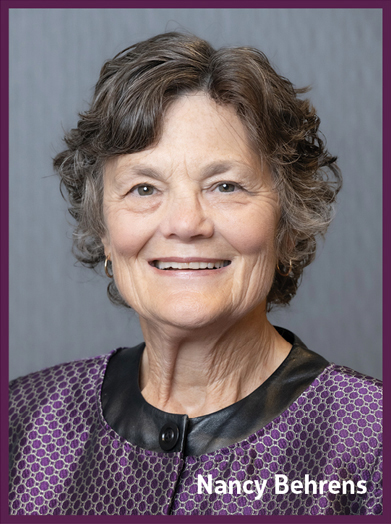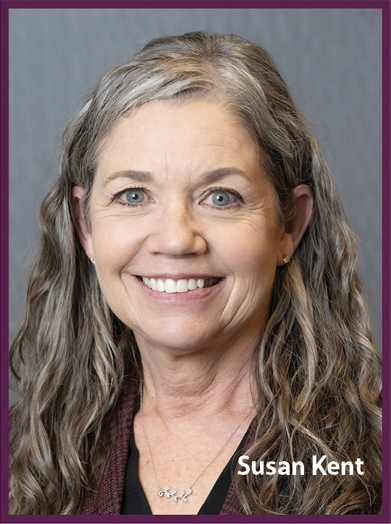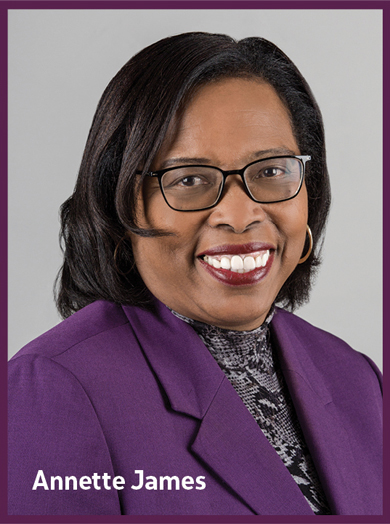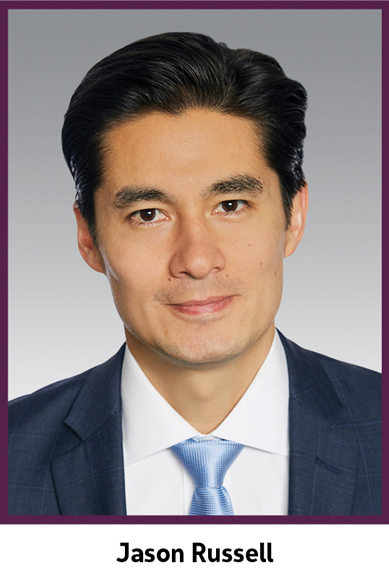
Practice Council Priorities for 2025
Council on Professionalism and Education
Nancy Behrens

The Council on Professionalism and Education (COPE) includes representatives of all Practice Councils as well as additional committees and boards that relate directly to professionalism and/or education needs of U.S. actuaries. This creates a unique opportunity to look across the work being done in any one of these areas and identify similar professionalism issues in other areas.
The Committee on Membership recently announced the new requirements for membership beginning on Jan. 1, 2026.
The Committee on Education (COE) will continue to develop materials related to elements of the Competency Framework that might not be covered in the curriculum for the CAS and SOA designations, with an immediate focus on the associate levels. While these items are few in number, they are important in ensuring that applicants for membership in the Academy have the resources to study in order to meet the new member requirements. The COE will continue to build out the U.S.-focused resources to support necessary knowledge in additional competencies as well.
COPE will continue to support the availability of educational opportunities to assist current Academy members in achieving their continuing education requirements. Relevant content will include professionalism and bias topics as well as technical aspects of actuarial work and updates on changing U.S. laws and regulations. This will be facilitated by Academy Learning, the new online platform that allows all members to access learning opportunities and help assess a member’s educational needs.
With so much discussion about self-regulation (see e.g. Brian Jackson’s excellent article in the November/ December 2024 issue of Contingencies), a major focus for COPE in 2025 will be raising awareness among members about the role the Academy and all actuaries play in maintaining self-regulation for U.S. actuaries. Two important aspects of this are:
- Ensuring actuaries are qualified to issue statements of actuarial opinion
- Encouraging actuaries to raise issues of potential violations of the Code of Conduct.
COPE will also be overseeing some special projects beginning in 2025. These include researching how and when the MAAA is referenced in various laws and regulations, the impacts of disruptive events, and building appropriate additional support for actuaries in maintaining self-regulation.
Casualty Practice Council
Susan Kent

The Casualty Practice Council (CPC) in 2025 will continue to further its goals of advancing the property and casualty actuarial profession in the United States and informing public policy in areas in which actuaries provide unique expertise and insight.
The CPC has convened two new task forces. The Homeowners Insurance Task Force is looking into issues such as affordability and home hardening, while the new Commercial Liability Insurance Task Force will be considering issues such as third-party-funded litigation and other developments in liability claims.
The Committee on Property and Liability Financial Reporting (COPLFR) will issue the Academy’s annual updates of the Practice Note on Statements of Actuarial Opinion on P/C Loss Reserves and the P/C Law Manual. COPLFR will also continue supporting the Academy’s in-person seminar on statements of actuarial opinion.
The Property and Casualty Committee on Equity and Fairness (PCCEF) will continue to be engaged with regulators on issues related to unintended bias in insurance pricing and the many state-led discussions. In 2025, the PCCEF is planning to expand its focus to include an issue brief on bias in marketing and underwriting.
The Committee on Cyber Risk continues to work with the NAIC Cybersecurity (H) Working Group and will be updating and enhancing the Cyber Risk Toolkit. For 2025, the Toolkit updates will include refreshes to previous papers. Additionally, the CPC continues to sponsor a Research Committee project on cyber risk together with the Risk Management and Financial Reporting Committee (RMFRC). The next phase of the research will seek to better understand the range of costs associated with cyber events.
The Climate Change Joint Committee (CCJC, a joint committee of RMFRC and the CPC) is planning papers on attribution science, data quality for climate models and applications, as well as mitigation successes. The Extreme Events and Property Lines Committee is planning on updating the flood monograph and working on a paper on complex/compound catastrophes. Additionally, the Actuaries Climate Index/Actuaries Climate Risk Index (ACI/ACRI) Work Group is moving to a new data source and will release an updated climate risk index in 2025.
The Casualty Loss Reserve Seminar Planning Committee will be developing sessions for the 2025 Casualty Loss Reserve Seminar, done in collaboration between the Academy and CAS, including a session on emerging risks.
Similarly, other committees are continuing to create additional work products:
The Property and Casualty Risk-Based Capital Committee will be furthering its work on solvency management tools by investigating diversification credits.
The Workers’ Compensation Committee is looking into “unusual animals” such as rating bureaus and state funds.
Finally, the CPC is looking forward to another round of Capitol Hill visits in 2025. Topics to be covered may include unintended bias in actuarial work, affordability issues, climate risk, and developments in cyber risk. These meetings between government stakeholders and volunteers are planned to be in person in 2025.
Health Practice Council
Annette James

While the recent elections might result in a change in the focus and approach to solving the challenges facing the U.S. healthcare system, the Health Practice Council (HPC) remains uniquely positioned to provide an objective and timely actuarial perspective to policymakers and other stakeholders on healthcare issues.
One key area of focus will be on improving the availability of, and access to, quality and affordable healthcare coverage. The HPC will continue to use our expertise to provide insights related to the implications of changes to health insurance policy, laws or regulations in the individual, employer group, Medicare, and Medicaid markets.
Our efforts will continue to highlight how any changes in public policy would affect insurance risk pools, premiums, and access to care among those with pre-existing health conditions.
Another area of focus will be on how healthcare providers are paid and how care is delivered. New models of healthcare payment and delivery are continually evolving while significant provider shortages persist. The HPC will continue to provide insights into the development and implications of new approaches to healthcare payment and delivery, including those related to value-based purchasing, prescription drug pricing, price transparency requirements, telehealth, and the use of artificial intelligence (AI).
The near- and long-term challenges of the Medicare program continue to be a focus of the HPC, as we help policymakers and other stakeholders understand the challenges to Medicare sustainability and the implications of changes to the Medicare program on trust fund solvency, program spending, beneficiaries, providers, and taxpayers. Similarly, our insights into the challenges of designing and financing long-term care systems-including private long-term care insurance and public programs that provide long-term services and supports to meet the needs of the changing demographics-is important to developing effective and sustainable long-term care systems.
We will continue to provide an actuarial perspective on the effects of a variety of public health challenges-including chronic diseases, infectious diseases, and behavioral health needs-on population health and healthcare spending.
Our health equity efforts will focus on enhancing our actuarial toolset by developing new ways of incorporating a broader range of outcomes and indirect cost and savings into the evaluation of benefits and programs intended to reduce health disparities. We will also work to understand how best to measure and quantify the unmet needs of the uninsured and underinsured.
Because our areas of focus overlap, our work requires coordination among HPC committees. Moreover, some of our issue areas- such as AI, climate change, and retirement security-overlap with the work of other practice areas. We will work together with other practice councils to further the mission of the Academy to serve the public and the actuarial profession.
We anticipate that 2025 will provide many opportunities for us to use our analytical lens and deep understanding of the complex U.S. healthcare system to address challenges, both foreseeable and unforeseen, as we continue to be a reliable resource for policymakers.
Life Practice Council
Jason Kehrberg

As we enter 2025, the Academy’s Life Practice Council is excited to share updates regarding activities and plans for the new year.
First, we are thrilled to announce our first Insurance Investment Summit, which will be held May 22-23 at the Marriott Marquis in New York City. This summit, hosted by the Academy’s Investment Analysis Subcommittee, will offer investment actuaries, asset managers, and other insurance investment executives working in Life/PRT, Health, and Property/Casualty a unique opportunity to network and hear from industry leaders, regulators and peers on topics covering the rapidly evolving world of insurance asset management.
The Subcommittee also continues working on educational articles and webinars for actuaries working in the investment space.
A key regulatory issue that will continue into 2025 is the NAIC’s continued work to develop a new Actuarial Guideline on Asset Adequacy Testing involving certain asset intensive offshore reinsurance transactions. The LPC will continue monitoring these developments and offer commentary on related regulatory exposures.
The Life Underwriting and Risk Classification subcommittee continues to monitor regulatory developments addressing the potential for unfair discrimination using advanced data analytics and AI, in particular the ongoing development and implementation of quantitative testing regulation for life insurance underwriting. The subcommittee is also developing a governance checklist for data bias and is updating the Model Governance Practice Note to reflect new practices related to using advanced data analytics and AI.
On the heels of this year’s VM-22 industry field test, the Annuity Reserves and Capital Subcommittee will continue to support regulators as they implementation of principles-based reserves for non-variable annuities with a target effective date of Jan. 1, 2026. The subcommittee is also working on a VM-22 practice note. In addition, the recently reconvened C3 Subcommittee is beginning work on a proposal for principal- based RBC C3 (interest rate risk) calculations that are consistent with the new principles-based VM-22 calculations for reserves. Also, the C1 Subcommittee continues working on a research project to study comparable attributes for Collateralized Loan Obligations (CLO) to support NAIC efforts to refine C1 (asset risk) RBC factors.
The Economic Scenario Generator Subcommittee will continue to monitor the NAIC’s multi-year Generator of Economic Scenarios (GOES) project to implement a new ESG for statutory reserve and capital calculations, offering commentary on regulatory exposures and developing related educational content and implementation considerations for practicing actuaries ahead of the target effective date for GOES of Jan. 1, 2026.
The Life Practice Council also has several new and updated publications planned for 2025. The Life Experience Committee will complete its new Resource and Discussion Guide for Fixed Indexed Annuities, the Tax Committee is developing an issue brief on excess interest reserves, the Index- Linked Variable Annuity Subcommittee is working on a new practice note on AG 54 regarding valuation of policies with index-linked crediting features, the Life Valuation Committee will update the Asset Adequacy Testing Practice Note, the Life Illustrations Subcommittee is updating the Life Illustrations Practice Note, the Non-Guaranteed Elements Subcommittee is developing a practice note on ASOP 2, the PBR Implementation Subcommittee is updating the practice note on credit for life reinsurance as well as the PBR portion of the practice note on model governance, and the Life GAAP Reporting Committee will update practice notes on SOP 03-1, SOP 05-1, FAS 133 (variable annuity guarantees), and FAS 157/159.
In summary, we have a busy year planned for 2025. If you have any interest in volunteering don’t hesitate to contact us!
Retirement Practice Council
Jason Russell

The Retirement Practice Council heads into 2025 ready to continue discussions on key pension and retirement issues within the actuarial community, with policymakers, and among public stakeholders.
Last year, we celebrated the 50th anniversary of the Employee Retirement Income Security Act of 1974 (ERISA) with the publication of both retrospective and forward-looking issue briefs. We also hosted a symposium on ERISA at 50 in which Academy volunteers and external thought leaders discussed the past, present, and future of the landmark legislation. In 2025, we celebrate another anniversary-the 90th anniversary of Social Security.
Building off of the conversation we’ve started in 2024, the Academy will continue focusing on how to address the program’s longer term solvency. Aligned with the Academy’s broader focus on equity, we will also focus on the impact of financial security across the retirement spectrum-with the impact on the financial disadvantaged, the rise of the gig economy, and the need for financial security literacy at both the policymaker and the individual consumer levels.
As we move into 2025, we will continue to expand on lessons learned from the first 50 years of ERISA and provide insights to inform future policy decisions to improve retirement security in the United States. The Academy believes assuring lifetime income is the most important facet of retirement security, and we will work with policy makers to explore ways to achieve this goal, through both traditional and non-traditional means, given the changing landscape of employment in America. We will also continue discussions to inform pension plan sponsors on risk management strategies, which also increases retirement security.
Social Security will continue to be a top priority for 2025. The latest projections show that Social Security trust fund assets are likely to be depleted in the next 10 years, which could mean benefit cuts of 20% or more. The Academy has encouraged Congress to take action to reform Social Security sooner rather than later, as delays could make the eventual solutions more difficult. The Academy will continue to contribute to these important discussions through various publications and issue briefs, as well as the “Social Security Challenge” interactive tool that allows stakeholders to model their own solutions.
We will continue to delve into issues that influence other public programs and the ongoing conversations related to the increase interest in defined benefit plans and the international refinement of defined contribution plans that may be attractive to U.S. employers and policymakers. Retirement security will continue to be a kitchen sink issue for so many, and we’ll be considering how our practice area can offer insights and opportunities within the other practice areas-particularly health and life. Following the election, we anticipate opportunities to educate new administration and congressional office staff, while continuing our efforts to collaborate with the federal and state agencies that we meet with on a regular basis. The Retirement Practice Council will also host a second externally focused symposium in 2025, following up on the successful ERISA at 50 Symposium, and the Social Security-focused breakout at last year’s Envision Tomorrow.
Risk Management and Financial Reporting Council
Steve Malerich

In 2025, the Risk Management and Financial Reporting Council (RMFRC) will expand on work that we’ve done in several areas over the past couple of years.
The Data Science and Analytics Committee (DSAC) is looking to finish its series of technical papers with the release of a paper, “Data as an Asset.” In addition, the committee has begun work on a paper about “Entropy and Diversity,” planned for release this year. DSAC’s Artificial Intelligence (AI) Subcommittee will be publishing an issue brief on how companies are using AI.
The Enterprise Risk Management/Own Risk and Solvency Assessment Committee (ERM/ORSA) will be producing a third episode in its Actuary Voices podcast series. Together with the Climate Change Joint Committee (CCJC, a joint committee of RMFRC and Casualty Practice Council), ERM/ORSA will release information on incorporating climate scenarios in risk assessment.
CCJC will also release an issue brief on attribution science, which estimates the contribution of climate change to various events. The committee will also release a paper on data quality.
The Financial Reporting Committee (FRC) made significant progress in 2024 on an IFRS 17 practice note to provide U.S.- specific content, supplementing International Actuarial Note 100, and will continue the project this year.
The Prudential Regulation Committee continues to monitor international developments. They currently anticipate another exposure of consultation papers by the International Association of Insurance Supervisors and plan to review and comment on the papers. The Behavioral Economics Work Group will be reporting results of their recent survey about companies’ use of behavioral economics.
As a council, we plan to have several committees involved in this year’s Capitol Hill visits.